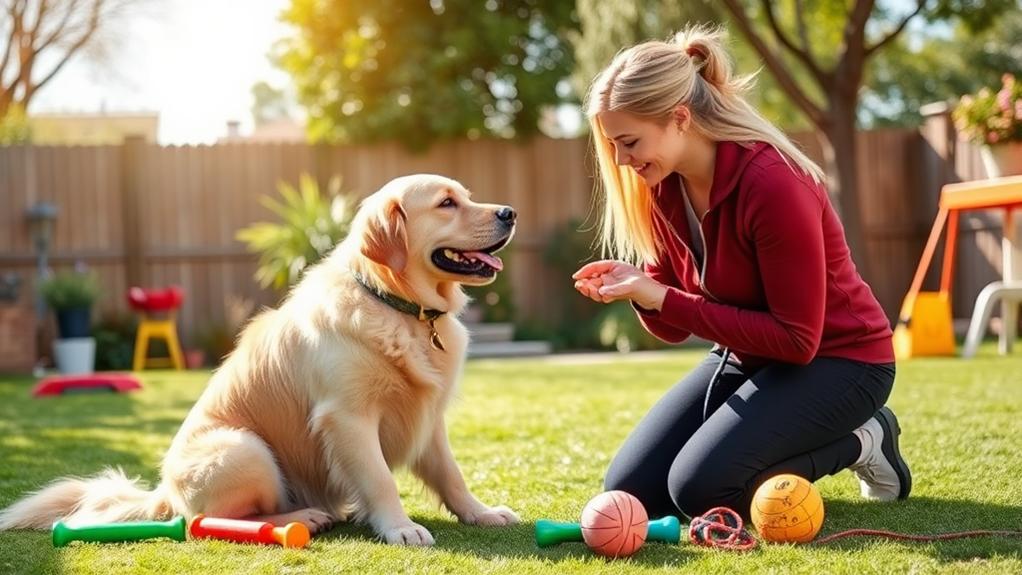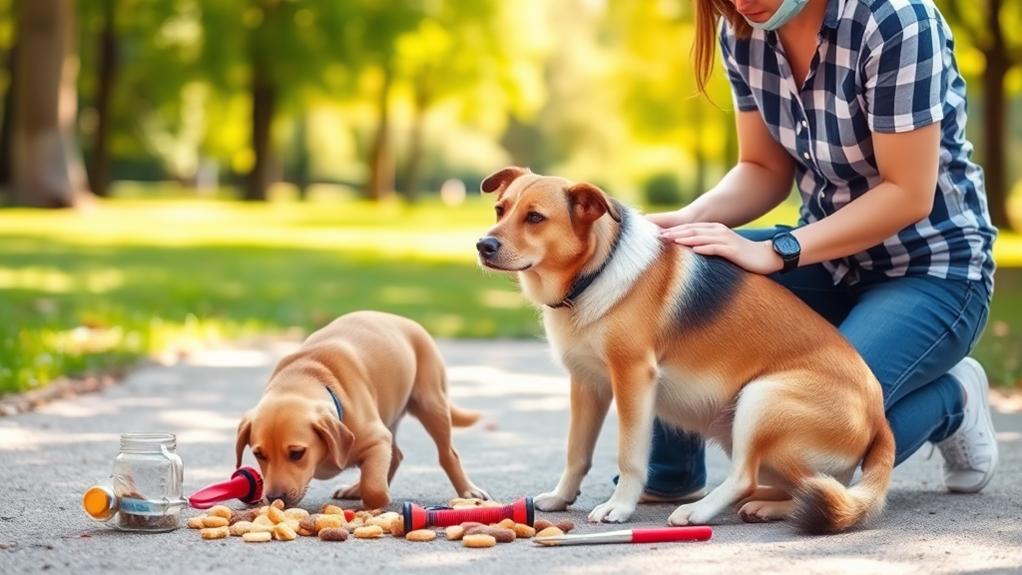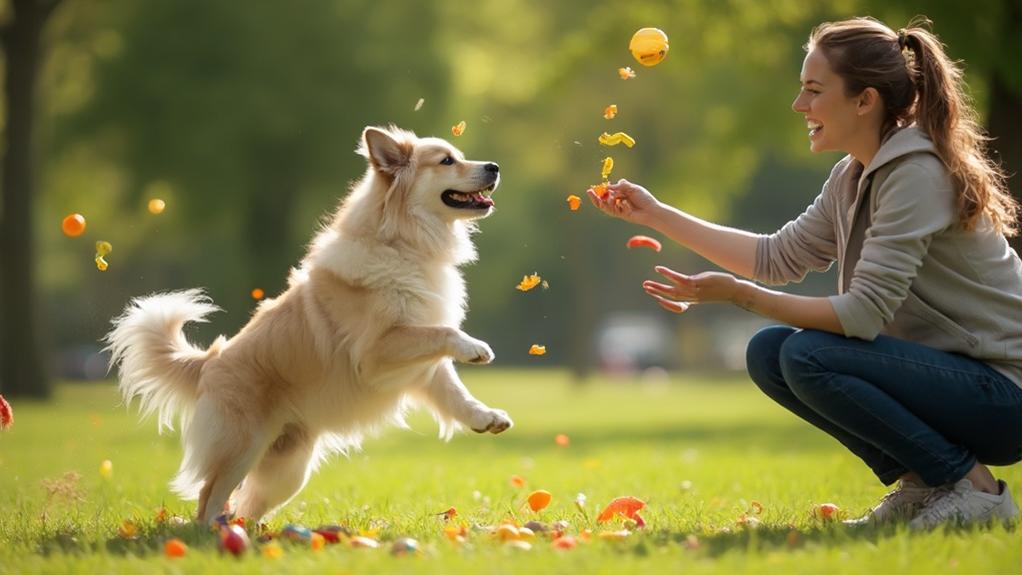To master dog training with rewards, focus on positive reinforcement. Reward your dog immediately after they exhibit the desired behavior to create a strong connection. Choose rewards that resonate with your pup, like treats, toys, or praise, and mix them up to keep things exciting. Maintain a consistent routine, short sessions, and clear goals for success. Remember, timing is vital – don't wait too long to give rewards. Effective praise and fun playtime can also motivate your dog. By observing your dog's reactions and tracking progress, you'll refine your approach and enhance your bond. There's much more to explore about perfecting this technique!
Understanding Positive Reinforcement
How can positive reinforcement transform your dog training experience? By using positive reinforcement, you create an enjoyable learning environment for both you and your dog. This method focuses on rewarding desired behaviors, which encourages your pup to repeat those actions. When your dog understands that good behavior leads to rewards, they're more likely to engage zealously in training sessions.
With positive reinforcement, you're not just correcting unwanted behaviors; you're building a strong bond based on trust and respect. Your dog learns to associate training with fun and rewards, making them more motivated to participate. This approach reduces fear and anxiety, leading to a happier, more confident dog.
Additionally, positive reinforcement helps you communicate effectively with your dog. By consistently rewarding the right behaviors, you clarify your expectations and reinforce the idea that good behavior pays off. The results can be remarkable, as your dog becomes more responsive to your commands and cues.
Incorporating positive reinforcement into your training routine can make each session enjoyable, productive, and rewarding. So, embrace this method, and watch your dog thrive as they learn and grow with you.
Choosing the Right Rewards

When it comes to dog training, selecting the right rewards can make all the difference in your pup's motivation and learning. Consider what truly excites your dog. Is it tasty treats, a favorite toy, or lots of praise? Each dog is unique, so observe their reactions to different rewards and use what works best.
For many dogs, high-value treats—like small pieces of chicken or cheese—can be a game-changer, especially during challenging training sessions. On the other hand, some dogs may respond better to playtime with a favorite toy or a good scratch behind the ears. Choose rewards that suit the training context; for example, use more enticing treats for complex commands and simpler ones for basic tasks.
It's also important to vary rewards to keep your dog engaged. If your pup gets too used to one type of reward, it might lose its effectiveness. Rotate between treats, toys, and affection to maintain their interest.
Ultimately, the right reward is one that your dog finds motivating. Pay attention, experiment, and you'll find the perfect incentives to help your furry friend learn and thrive.
Timing Is Everything
Selecting the right rewards is only part of effective dog training; knowing when to deliver them is just as important. Timing can remarkably impact how quickly your dog learns. If you reward your pup too late, they might not connect the behavior with the reward. Here are four key points to remember about timing:
- Immediate Rewards: Deliver the reward immediately after your dog performs the desired behavior. This helps reinforce the action clearly.
- Consistent Timing: Use a consistent timeline for rewards during training sessions. This builds a predictable pattern for your dog.
- Short Training Sessions: Keep training sessions brief. Dogs have short attention spans, and effective timing means rewarding within that time frame.
- Gradual Delays: As your dog masters a behavior, you can gradually increase the time before delivering the reward. This helps shift them to relying on your praise rather than just treats.
Types of Rewards to Use

Rewards play an essential role in dog training, as they motivate your pup to repeat desired behaviors. Understanding the different types of rewards can help you find what resonates best with your dog.
One of the most common rewards is food. Treats are often effective because they engage your dog's sense of smell and taste. Choose small, tasty morsels that your dog loves, and always keep them handy during training sessions.
Another effective reward is praise. Your pup thrives on your approval, so use enthusiastic words and a happy tone whenever they succeed. This emotional reinforcement can strengthen your bond and enhance your training outcomes.
Toys can also serve as rewards. If your dog enjoys playing fetch or tug-of-war, use their favorite toy as a reward for good behavior. The excitement of play can be a powerful motivator.
Lastly, consider the option of physical affection. Simple gestures like petting, belly rubs, or cuddling can make your dog feel loved and appreciated, reinforcing their positive actions.
Experiment with these rewards to find the right mix that keeps your dog engaged and willing to learn!
Setting Clear Training Goals

To maximize the effectiveness of your training sessions, it's important to set clear training goals. Clear goals give you direction and help you measure progress. When you know what you want to achieve, you can focus your efforts and keep your dog motivated.
Here are four key steps to setting effective training goals:
- Be Specific: Instead of saying, "I want my dog to be obedient," define specific behaviors you want to teach, like "sit" or "stay."
- Make It Measurable: Set criteria to determine success. For example, aim for your dog to sit on command 80% of the time during training sessions.
- Set Realistic Expectations: Be honest about your dog's abilities and your training timeline. If your dog is new to training, start with basic commands before moving on to more complex behaviors.
- Time-Bound Goals: Establish a timeframe for achieving your goals. For instance, you might aim for your dog to master "sit" within two weeks.
Building a Training Routine

Establishing a consistent training routine is essential for your dog's learning process. Dogs thrive on predictability, and a regular schedule helps them understand when to expect training. Start by setting aside specific times each day dedicated to training sessions. Short, focused sessions—around 5 to 10 minutes—work best, as they keep your dog engaged without overwhelming them.
Choose a quiet space free from distractions to help your dog concentrate. It's also important to vary the training exercises to keep things interesting. Mix basic commands like "sit" and "stay" with new tricks to maintain their enthusiasm.
Consistency is key. Use the same commands and gestures each time, so your dog learns to associate them with specific actions. If you're training with other family members, make sure everyone is on the same page to avoid confusion.
Remember to stay patient and positive throughout the process. If your dog struggles with a command, don't hesitate to revisit it in future sessions. By sticking to this routine, you'll not only build your dog's skills but also strengthen your bond, making training a rewarding experience for both of you.
Using Praise Effectively

Incorporating praise into your training routine can greatly enhance your dog's learning experience. When you use praise effectively, you reinforce desired behaviors, helping your dog understand what you expect. Here are some tips to maximize the impact of your praise:
- Be Specific: Instead of just saying "good dog," specify what behavior you're praising, like "good sit!" This clarity helps your dog connect the praise to the action.
- Use a Happy Tone: Your dog can sense your emotions. Use an upbeat, enthusiastic tone to convey excitement and make your dog feel rewarded.
- Timing is Key: Praise your dog immediately after they perform the desired behavior. This instant reinforcement helps them associate the action with the praise.
- Vary Your Praise: Mix verbal praise with physical affection, such as petting or a gentle scratch behind the ears. This keeps things interesting and engages your dog on multiple levels.
Incorporating Playtime as Reward

Playtime can be one of the most effective rewards in dog training, offering a fun way to motivate your furry friend. When you incorporate playtime into your training sessions, you not only enhance your dog's enjoyment but also strengthen your bond. Dogs thrive on interaction, and using play as a reward taps into their natural instincts.
To effectively use playtime as a reward, choose activities your dog loves, like fetch, tug-of-war, or simply chasing a ball. Whenever your dog successfully follows a command or displays good behavior, immediately engage them in a play session. This instant reward reinforces the desired behavior and encourages them to repeat it.
Make sure to vary the playtime activities to keep things exciting. If your dog seems to lose interest, you can switch to a different toy or game. Remember, the goal is to keep your dog motivated and enthusiastic to learn.
Always end the play session on a positive note, ensuring your dog feels satisfied and happy. This way, they'll look forward to training sessions, knowing that fun is just around the corner. Playtime can truly transform your training experience!
Common Training Mistakes to Avoid

As you enjoy playtime with your dog, it's important to be aware of common training mistakes that can hinder your progress. Recognizing and avoiding these pitfalls will help you train effectively and strengthen your bond with your furry friend.
- Inconsistent Commands: Using different words for the same command confuses your dog. Stick to one term for each behavior to guarantee clarity.
- Lack of Timing: If you reward or correct your dog too late, they won't connect the action with the response. Immediate feedback is vital for effective training.
- Overusing Treats: While rewards are essential, relying solely on treats can create dependency. Mix up your rewards with praise, play, or affection to maintain your dog's interest.
- Ignoring Distractions: Failing to train in various environments can limit your dog's ability to respond to commands in real-life situations. Practice in different settings to confirm your dog is well-prepared.
Tracking Progress and Adjustments

Tracking your dog's training progress is crucial for making effective adjustments. By keeping a close eye on how your dog responds to different techniques and rewards, you can identify what works and what doesn't. Start by maintaining a training journal or using an app to log each session. Note the commands practiced, your dog's behavior, and any rewards given.
After a few weeks, review your notes. If your dog consistently struggles with a particular command, consider changing your approach. Maybe the reward isn't motivating enough, or perhaps the timing of your praise needs adjustment. Pay attention to your dog's body language; it's a key indicator of their understanding and comfort level.
Additionally, don't hesitate to celebrate small victories. If your dog learns a new command or shows improvement, reward them immediately. This reinforces positive behavior and builds confidence.
Conclusion
Mastering dog training with rewards can transform your relationship with your pup. By understanding positive reinforcement and choosing the right rewards, you're setting your dog up for success. Remember, timing is essential, and don't underestimate the power of praise and play. Keep your training goals clear and track progress to make necessary adjustments. Avoid common pitfalls, and you'll create a fun, effective training environment. With patience and consistency, you'll see amazing results in no time!



